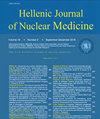Comparative study of the most commonly-used radiopharmaceuticals for PSMA prostate PET/CT imaging.
IF 0.9
4区 医学
Q4 RADIOLOGY, NUCLEAR MEDICINE & MEDICAL IMAGING
引用次数: 0
Abstract
Prostate cancer (PCa) is one of the most common malignancies and cause of cancer death in men. Prostate-specific antigen (PSA) is the most used biomarker in the detection of early PCa. Lately, scientists have been using prostate-specific membrane antigen (PSMA), a glycol-protein that is over-expressed in PCa cells in positron emission tomography/ computed tomography (PET/CT) scans to detect PCa. Gallium-68-PSMA radiotracers, such as 68Ga-PSMA-11, 68Ga-PSMA-617 and 68Ga-PSMA I&T, were firstly introduced in 2011 and fluorine-18-PSMA based radiotracers followed with 18F-PSMA-1007,N-[N-[(S)-1,3-dicarboxypropyl]carbamoyl]- 4-18F-fluorobenzyl-L-cysteine(18F-DCFBC) and 2-(3-(1-carboxy-5-[(6-[18F]fluoro-pyridine-3-carbonyl)-amino]-pentyl)-ureido)- pentanedioic acid (18F-DCFPyL), also known as PYLARIFY, being the most used and showed superior results compared to conventional imaging techniques. Differences depending on half-life, clearance and normal organ uptake are being detected through research to determine which of the radiotracers, is the most suitable for each patient. Two of them, 68Ga-PSMA-11 and PLYRIFY, have already been approved by the Food and Drug Administration (FDA). The future of hybrid imaging for PCa is very promising if we consider the advantages of PSMA radiotracers compared to non-PSMA radioligands.PSMA前列腺PET/CT成像最常用放射性药物的比较研究。
前列腺癌(PCa)是最常见的恶性肿瘤之一,也是男性癌症死亡的原因。前列腺特异性抗原(PSA)是早期前列腺癌检测中最常用的生物标志物。最近,科学家们一直在使用前列腺特异性膜抗原(PSMA),一种在正电子发射断层扫描/计算机断层扫描(PET/CT)中在前列腺癌细胞中过表达的乙二醇蛋白来检测前列腺癌。镓-68- psma示踪剂,如68Ga-PSMA-11、68Ga-PSMA-617和68Ga-PSMA I&T,于2011年首次推出,氟-18- psma示踪剂紧随其后的是18F- psma -1007、N-[N-[(S)-1,3-二羧基]氨基甲酰基]- 4-18F-氟乙酶- l-半胱氨酸(18F- dcfbc)和2-(3-(1-羧基-3-羰基)-氨基]-戊基)-脲基)-戊二酸(18F- dcfpyl),也称为PYLARIFY,使用最多,与传统成像技术相比显示出优异的结果。根据半衰期、清除率和正常器官摄取的差异,正在通过研究来确定哪种放射性示踪剂最适合每个病人。其中的两种,68Ga-PSMA-11和PLYRIFY,已经获得了美国食品和药物管理局(FDA)的批准。如果我们考虑到PSMA放射性示踪剂与非PSMA放射性配体相比的优势,那么PCa混合成像的未来是非常有希望的。
本文章由计算机程序翻译,如有差异,请以英文原文为准。
求助全文
约1分钟内获得全文
求助全文
来源期刊
CiteScore
1.40
自引率
6.70%
发文量
34
审稿时长
>12 weeks
期刊介绍:
The Hellenic Journal of Nuclear Medicine published by the Hellenic Society of
Nuclear Medicine in Thessaloniki, aims to contribute to research, to education and
cover the scientific and professional interests of physicians, in the field of nuclear
medicine and in medicine in general. The journal may publish papers of nuclear
medicine and also papers that refer to related subjects as dosimetry, computer science,
targeting of gene expression, radioimmunoassay, radiation protection, biology, cell
trafficking, related historical brief reviews and other related subjects. Original papers
are preferred. The journal may after special agreement publish supplements covering
important subjects, dully reviewed and subscripted separately.

 求助内容:
求助内容: 应助结果提醒方式:
应助结果提醒方式:


